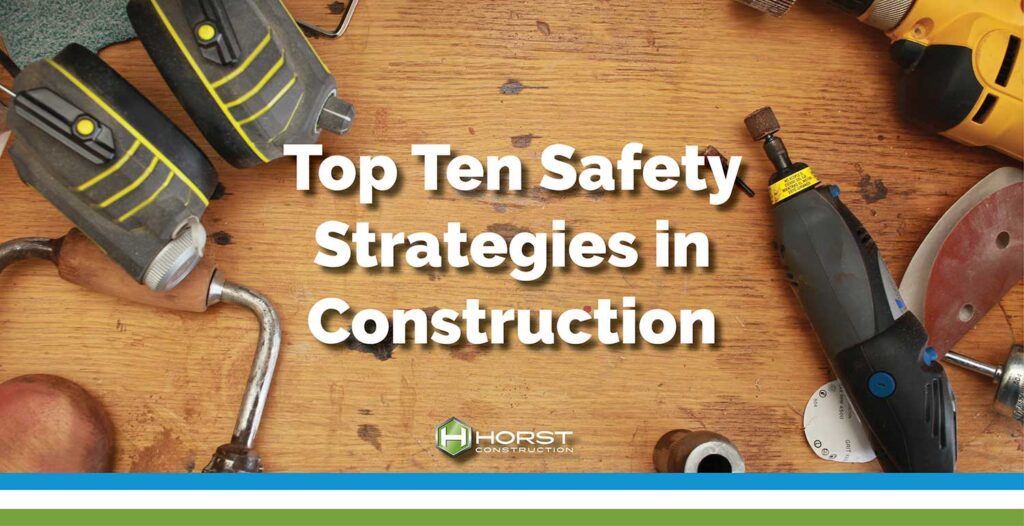Top Ten Safety Strategies in Construction

When it comes to Safety in the Construction Business, expert Joe Heller can teach all of us a few things. Having been a biology teacher early on in his career, Joe knows the difference between science and the application of science in the field. In the case of safety, what’s important is the difference between Safety Science and Safety Law. With almost 40 years of experience running the safety program at Horst, he advises that if anyone is faced with a decision between what is safe and what is strictly legal, they should do it the safe way.
Here are Joe’s Top 10 Safety Strategies:
1. Use Project-Specific Safety Programs
Some projects have hazards that ‘standard’ safety programs may not address. Project-specific safety programs help address this challenge. Some tips include:
- Identifying the special hazards associated with that site and adding those items to the safety program template
- Creating site-specific safety programs customized to that site will help avoid related injuries and OSHA allegations
2. Maintain Good Subcontractor and Supplier Relationships
We strive to be good partners with our subcontractors and suppliers in a united effort to provide exceptional Productivity, Quality, and Safety (PQS). How do we accomplish that on site? Since we are not experts on everything, we expect the subcontractor to provide expertise in their area. That’s why we train our foremen to manage PQS through the subcontractor. We have a system of designated competent people on the site, so our foreman can go directly to the person with the expertise to resolve the concern.
3. Define Your Objectives
The Horst definition of safety is “working without harming ourselves or others.” The first word—“working”—is very important because we exist as a company to perform work, not just to be safe. BUT WE MUST BE SAFE IN ORDER TO KEEP ON WORKING. Joe cringes when he hears the phrase “safety first,” because it defies the reality of why the business exists. In the case of Horst, that’s to create exceptional environments–safely, of course.
4. Measure Progress Toward Your Objectives
Horst, and many other construction companies, measure safety by:
- No fatalities
- Injury rates at least 10% better than the industry average
- No uncontested OSHA citations
5. Move Steadily Toward Your Objectives
Key steps toward improved safety include:
- Wanting to do so—we try to perform safely, and in ways that bring value.
- Improving job knowledge—the more knowledgeable we are about our jobs and constantly striving to improve our performance, the easier it is to perform these tasks without bringing harm to ourselves or others.
- Focusing on job training—which helps us to perform our specific roles safely.
- Developing quality partnerships with supervisors—across production, quality, and safety goal lines.
6. Access and Use Insurance Partner Services
At Horst, we select insurance partners who provide exceptional loss control support services that include independent project observations. We also encourage and benefit from regular site visits by the insurance company’s loss control specialist.
7. Access and Use Construction Industry Support Services
We partner with industry and business associations that provide exceptional support services. One we often use is ABC, Associated Builders & Contractors, Inc.
8. Access and Use Legislative Support Services
At Horst, we maintain regular contact with our elected representatives to foster a mutual understanding of emerging regulatory actions. This goes back to Joe’s statements about the difference between Safety Science and Safety Law. Sometimes good science does not equal good laws. Our relationships also allow us to be proactive when it comes to regulatory compliance issues.
9. Access and Use OSHA Standards
Staying current with regulatory changes is a continuing challenge. The most recent OSHA standards are available at www.osha.gov/ and are included in the Horst Field Manual by reference. OSHA standards are mandatory across all segments of our company operation.
10. Teach The Economic Value of Safety
Safety pays:
- Increased job value—retention of experienced employees due to a safe working environment.
- Increased productivity and profits—employees’ productivity is much higher in a safe work environment and accident costs can quickly offset the profitability of a project. We must be safe to prosper!
Want to know more about Horst’s Safety Program? Contact Us.
Posted May 08, 2017

